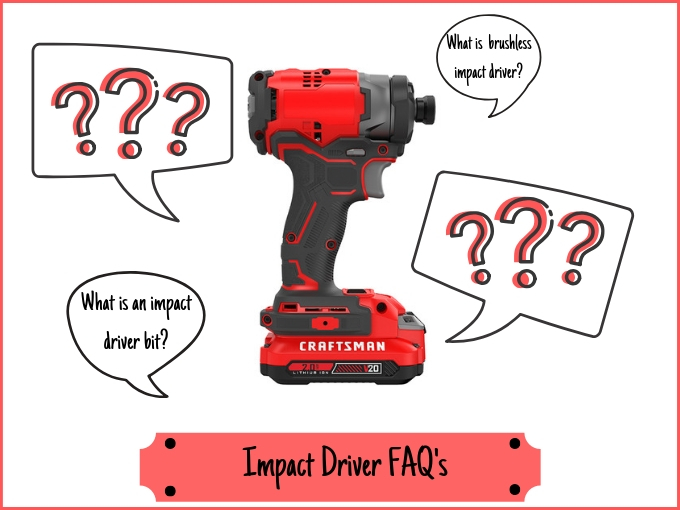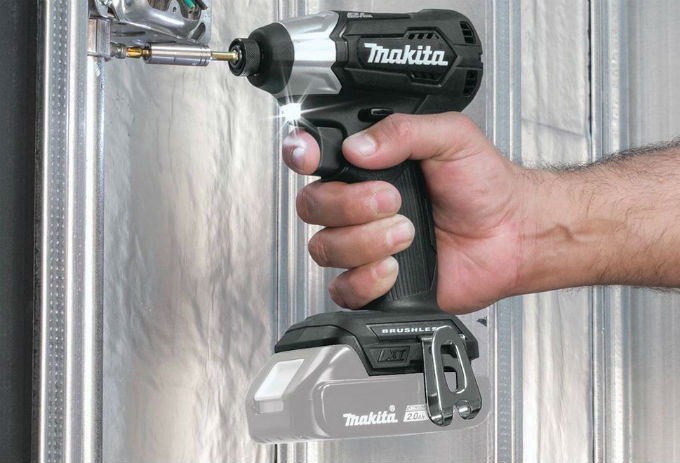
Impact drivers are lighter, more compact and deliver more torque than your typical screwdriver, and there are several impact driver features you should be familiar with.
Impact drivers may not be as versatile as your general purpose power drill, but the time savings one of these tools can give you can be substantial. If you’re taking off a lot of screws and bolts in the workshop or in the garage, an impact driver delivers the torque and impact blows that make the task a lot faster.
Another main advantage of the impact driver, and the high torque operation it provides you with, is that you are less likely to strip screws and bolts. For driving longer screws into hardwood or thick pieces of dimensional lumber, few tools will beat an impact driver for that job. Also, the short stubby bodies of most impact drivers also make it a lot easier to use them in tight spaces.
What’s a Brushless Impact Driver?
A brushless impact driver is simply an impact driver that comes with a brushless motor. So what are brushless motors? These are a different kind of motor that does away with contact brushes.
Brushless motors have started finding their ways into power tools since the early 2000s, and manufacturers claim that brushless impact drivers can deliver superior performance, energy efficiency, and durability in addition to less maintenance downtime.
A typical brushless motor that you will find in power tools does not have brushes that need to be replaced. They also do away with the commutator, too. Instead of contact brushes, brushless motors have a small circuit board that controls the direction of the current delivered to the windings to keep the motor rotating.
The windings in brushless motors are also stationary, which makes the shaft simpler and more lightweight. As a result, manufacturers can build larger and more efficient windings without having to worry about the speed-up time of the motor.
Larger windings made with thicker copper wire make for more efficient motors, plus there is less friction without the physical contact between brushes and the commutator.
Since you also have an electronic board running the motor, manufacturers can build a lot of “smart” features into the motor itself. You will usually find brushless impact drivers that come with overvoltage and kickback protection or variable speed control.
On the other hand, brushless impact drivers are a lot more expensive compared to regular impact drivers – expect them to be at least 30 percent more expensive compared to the comparable impact drivers with brushed motors.
You will typically find brushless models in the higher price ranges of cordless impact drivers, where their power efficiency and safety features make a lot more sense. You can expect brushless impact drivers to become more affordable in the coming years, though, as the technology becomes more mature for consumer grade power tools.
What is an Impact Driver Bit?
An impact driver bit is usually a hex shank that you can use that are specifically designed for impact drivers. Impact drivers use a different mechanism to run the bits you attach to them, hence the need for a more effective shank design for them.
Quality impact driver hex bits typically come with 1/4 inch diameter shafts, and you can use them in a traditional drill as well. The difference that the impact driver bits can give you is their ability to withstand more torque. They are engineered to last longer and deliver slip-free performance even when subjected to high torque over hundreds of fasteners.
Many of these bits are advertised as “impact bits”, “impact grade” or “impact ready bits,” and they usually come with surface treatments such as black oxide coatings that give them extra wear resistance and strength.
Impact driver bits can be sold in sets, which includes 30 bits or more along with a compact organizing kit or can be purchased individually. These bits will usually include the most common tips for the different fasteners you might use in your project.
A typical kit may include Phillips and flat head bits in varying sizes, as well as more uncommon tips for square and Torx heads. Some kits may also include adapters that let you use 1/2 inch bits with a 1/4 impact driver as well.
What is the Difference Between a 1/4 and 1/2 Impact Driver?
The main difference between a 1/4 impact driver and a 1/2 impact driver is in the drives they use. A 1/4 impact driver will have a hex drive that accepts 1/4 inch bits, just like the name suggests.
On the other hand, a 1/2 impact driver uses a square driver, and these can only use the larger 1/2 inch square shaft bits. Some impact drivers can use an adapter bit that lets you fit 1/2 square shaft bits into a 1/4 impact driver, or the other way around.
The impact drivers that come with 1/2 square drives can use many of the bits designed for impact wrenches. Impact wrenches, in fact, are the larger, bulkier, and more powerful versions of impact drivers.
Just like their name suggests, their main purpose is to loosen or fasten sockets quickly and efficiently. Larger 1/2 impact drivers and impact wrenches are ideal for mechanical work, garage projects, and racing pit stops where speed and efficiency are desirable.
What is a Compact Impact Driver?
Impact drivers are short, stubby tools that you can easily fit into tight spaces. If you work in really tight spots like inside engine bays or machinery, you will surely appreciate having a compact impact driver – the smaller and more lightweight versions of the tool.
A compact impact driver can weigh as little as less than two pounds, and will look more like a handheld glue stick gun that will barely peek out of your hand. Don’t underestimate their power, though – these tiny tools will still make short work of driving longer screws into wood, or wrenching off rusted bolts or sockets.
For cordless impact driver models, you can generally expect their compact versions to come in 12 volts or so. Many of these compact impact drivers will measure less than six inches at their longest, and they will not take a lot of space in your toolbox or car trunk at all. For the best compact impact driver you can get for the really tight spaces, you will do well by picking up a model that comes with LED lights.
What is a Cordless Impact Driver?
A cordless impact driver is simply an impact driver that is powered by its own battery pack. They do not need to be plugged into a power outlet to get them running, which means that you can use a cordless impact driver just about anywhere. With no cord to get in the way, a cordless impact driver lets you work under vehicles, on top of ladders, or in outdoor locations with no set-up required.
On the other hand, you have a limited running time depending on the amount of charge you have left in your batteries. Cordless impact drivers also tend to lag behind the corded and pneumatic models when it comes to power and performance, although recent advances in brushless motor technology and lithium-ion batteries have managed to narrow the gap somewhat.
Another thing to consider before getting a cordless impact driver is their price. The cost of the battery pack and the charger adds a big premium to the price of cordless models, and brushless cordless impact drivers also tend to be in the higher brackets when it comes to price.
Cordless impact drivers are rated in terms of voltage, while corded models are rated in terms of amperage instead. Compact or lightweight impact driver models start at around 12 volts, and on to the 18 and 20-volt models. As for the batteries, their capacities are rated in terms of Ampere-hours or Ah.
Most models come with a 2 Ah battery that takes around 30 minutes to get fully charged. Cordless impact drivers also come as bare tools with no batteries or chargers, if you are looking for a more affordable kit that’s compatible with battery packs and chargers that you already own.


